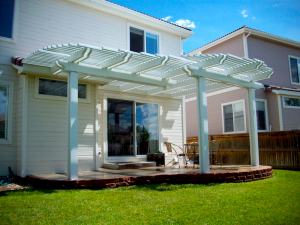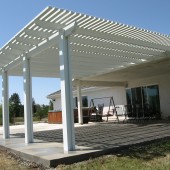Wooden patio covers are nothing new – there have been several innovations since their conception that may have made them outdated and made them a sub optimal choice to any homeowner..
In this article we delve a little deeper into the pros and cons of wooden patio covers, and try and help you decide if they are the right product for you (or if there are better alternatives)
What type of wood?
Patio covers are always exposed to the harsh outdoor elements so choosing what type of wood to use is important. The wood that is chosen should be able to endure all climates and subsequently, result in the least amount of maintenance. Pine is a wood that will easily hold paint.
However, pine does not have the anti-rotting agents that hard woods have – so like all other softwoods they are generally unacceptable choices. (This is with the exception of the amazing southern yellow pine). Redwood, cedar and cypress are some commonly stated options that are recommended by experts. As long as you choose a hard wood that has a reasonably long grain and treat / stain / paint it properly you should be fine.
Which Type Of Design?
Flat roof is the most popular form of patio design. Users who opt for the “Flat Roof” style have the option to either opt for solid or lattice roofing. The solid option is best for people that are expecting adverse weather conditions – loads of sun, or loads of rain – shade and shelter will not get much better than this.

This white lattice patio cover made from wood is the picture perfect example of what a cover should look like..
Whereas, the “lattice” style of design is a great middle ground between blocking the sun light completely and having a little bit of shade. The lattice option is certainly the most attractive – solid sides patio covers can often look like converted garden sheds – which to many people is certainly not the ideal look!
However it all depends on what your needs are – and properly designed solid flat roof patio covers can certainly look attractive. You can also get free standing wood patio cover kits which are an excellent innovation. They require no foundations to install and can be easily put up by anyone that can use a hammer over a weekend.
Customizing your Patio
Many wooden patio owners choose to buy motorized retractable awnings that attach beneath patio covers. These facilitate a more controlled shade and extend the protection offered by the patio cover if you have guests over – they do however look a little unsightly from time to time.
Planting vines or climbing bushes along the roof of the patio cover can help create a relaxing environment for the owner and their guests. And is lovely on a summers day when you want a little shade and the sun pours through the tiny gaps in the plants.
Vinyl covers are useful for the winter months which will cover your patio cover protecting it from the harsh elements. They are a little tricky to get on and off – which is why they are best left to the winter when you are less likely to be using the patio.
Aluminum vs wood patio covers
Homeowners are shifting to modern materials of construction such as plastics and mainly aluminum. Mainly because of the ease of construction and the ability to withstand harsh exterior elements. They are notably cheaper to install than wooden patio covers too.

this solid roof patio cover that is still under construction shows what i mean by they look like a “garden shed”
Things like alumawood have come to the market – which combines the look of wood, with the durability of aluminum. They are as amazing as they sound (and they should be as they cost loads more than a wood patio cover).
These modern materials are lightweight and hence, do not require substantial groundworks or foundations to install – they do not rot, and will generally last longer than wooden patios – so are they better?
Pros and Cons
Wood patio covers are the traditional and most popular choice for homeowners who want natural beauty and elegance. Wood tends to naturally blend with the outdoors, and is pretty much guaranteed to fit in with any style of garden.
Aside from their natural beauty and elegance, wooden patio covers are also preferred by homeowners because they can be painted with any color of their preference with ease (compared to other materials commonly used for patios). However it is important to factor in all the cons as well.
Wooden patios need to be painted repeatedly at regular intervals and treated for termites. This is the main drawback of wooden patios – they tend to have a finite lifespan, and do require regular maintenance when compared to their aluminum and plastic cousins.
So in a nutshell it comes down to personal preference. Aluminum and plastic patio covers are certainly the most practical – but are pretty unsightly compared to wooden patio covers..
Function or fashion.. You decide.






